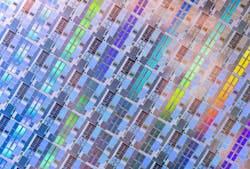Synopsys Partners With Microsoft to Take EDA to the Cloud
Synopsys is partnering with Microsoft to help more semiconductor companies move into the cloud.
The Silicon Valley company on Monday unveiled a new “software as a service” offering for its chip design tools that run on top of Microsoft’s Azure cloud service. Called Synopsys Cloud, it gives chip engineers on-demand access to a broad range of chip design and verification tools from Synopsys and computing resources from Microsoft that the tools run on—allowing them to pay only for what they use.
Synopsys is one of the world’s largest suppliers of electronic-design-automation (EDA) software used in chip design. With Synopsys Cloud, companies can rent out the software tools from Synopsys by the hour instead of buying software licenses and running the programs on-site.
Rani Borkar, who leads hardware systems and infrastructure for Microsoft’s Azure business, said the service “marks a significant milestone for the industry by offering silicon design teams the ability to scale and accelerate their development cycles—transforming chip design the way the cloud transformed computing.”
Clouds on the Horizon
Designing modern chips is a complicated three-dimensional design problem that can take several years. The chips have become so intricate that it is impossible for engineers to design every single detail by themselves. Instead, they use EDA software to automate many of the steps in this process: from arranging components on the floorplan of the processor to verifying its performance and preparing it for final production at a fab.
“Addressing systemic complexity along with interdependent design flows in chip design requires more compute and EDA resources than ever before,” stated Borkar.
Today, the most advanced computer chips contain billions of transistors that are arranged into millions of logic gates. Simulating a chip ahead of volume production takes a massive amount of computing power; thus, companies tend to lean on colossal in-house data centers largely devoted to running EDA workloads.
But now everyone from top-tier chip makers to startups is moving more of these workloads to the cloud in a bid to boost productivity for increasingly complex chip designs. Arm plans to move the majority of its EDA workloads to Arm-based cloud services at AWS. Last year, NXP Semiconductors said it also shifted most of its EDA workloads to AWS to help it design new chips faster and keep development costs in check.
Renting out resources over the cloud will help stop semiconductor firms from over- or under-spending on their internal data centers. It will also help reduce the risk of not having enough computing resources on hand to simulate increasingly intricate chips designs. By moving EDA workloads to the cloud, companies are trying to give their engineers more time to focus on designing chips and less on managing in-house servers.
Extra Flexibility
For Synopsys, the goal is to give its customers the flexibility to run chip design workloads where they see fit.
Synopsys has partnered with top cloud providers in the U.S., including Alphabet’s Google, Amazon Web Services (AWS), and Microsoft Azure to allow its customers to deploy EDA tools on public cloud services.
It has also worked very closely with leading contract chip foundries such as GlobalFoundries, Samsung, and TSMC to make sure its cloud-based offerings work with their libraries and process design kits (PDKs).
But with the new “software as a service” offering from Synopsys, customers can directly access and pay as they go for compute resources from Azure and preconfigured cloud-based chip design tools from Synopsys.
Customers that already rent out computing resources from Amazon, Google, Microsoft, or other public cloud-computing services can also take advantage of Synopsys Cloud in a “bring your own cloud” approach.
That gives its customers the ability to dial computing resources up or down in response to their changing chip design and verification needs, instead of investing in upgrades to their data centers long term. That lets them do things such as reduce processing time on verification tasks or save runtime while modeling the performance of a new chip design. Having on-demand infrastructure helps curb costs and time-to-market.
"As more design flows incorporate AI, requiring even more resources, the virtually unlimited compute and EDA access we're providing will lay the foundation for new levels of semiconductor innovation while delivering a flexible, secure chip development environment for future demands,” added Sassine Ghazi, chief operating officer at Synopsys.
Microsoft said Synopsys Cloud is powered by AMD’s latest EPYC processors with 3D V-Cache technology.
Companies can sign up for Synopsys Cloud now.
About the Author
James Morra
Senior Editor
James Morra is the senior editor for Electronic Design, covering the semiconductor industry and new technology trends, with a focus on power electronics and power management. He also reports on the business behind electrical engineering, including the electronics supply chain. He joined Electronic Design in 2015 and is based in Chicago, Illinois.

